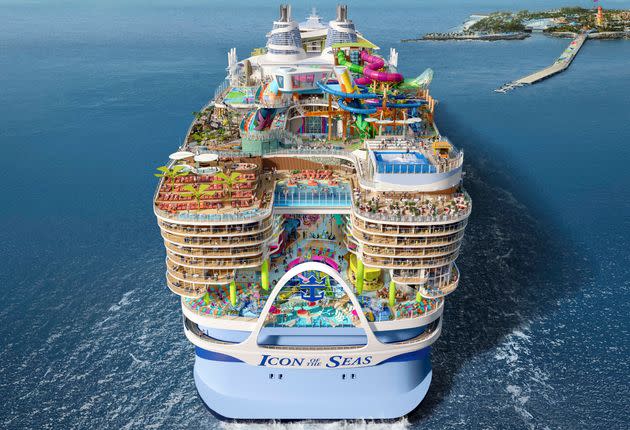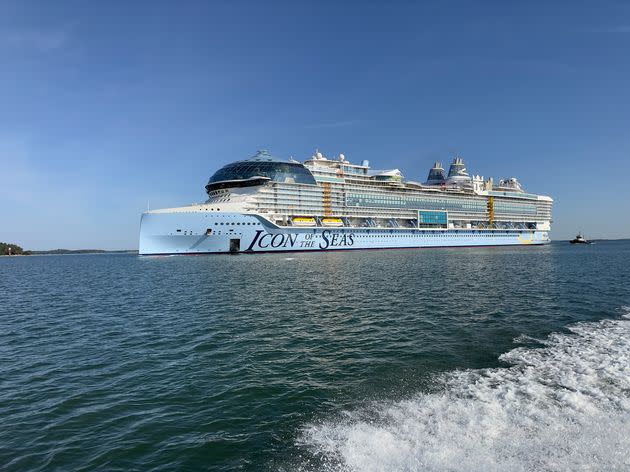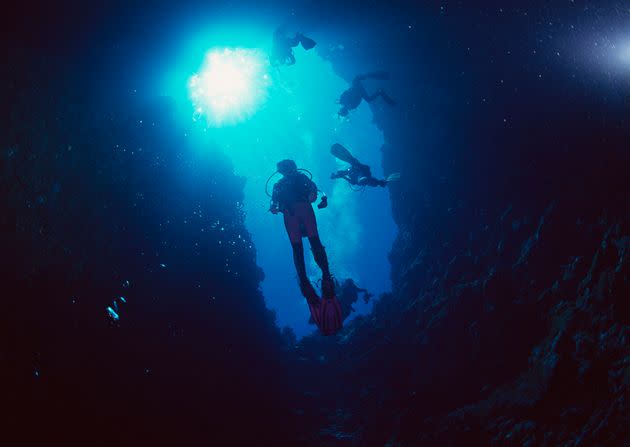Why That Viral Photo Of A Massive Cruise Ship Is Freaking Everyone Out

Royal Caribbean’s "Icon of the Seas" has everyone feeling some kind of way: For most, it's heightened anxiety.
Earlier this week, the internet got its first look at a very big boat. When we say “big boat,” we mean gobsmackingly big. Massive. Five-times-the-size-and-weight-of-the-Titanic big.
The boat in question is the new “Icon of the Seas,” the world’s biggest cruise ship, set to join the Royal Caribbean fleet on Oct. 26. It will be ready for the public in 2024.
The liner ― which includes the biggest water park at sea, its own “Central Park,” eight “neighborhoods,” and 20 total decks ― has room for 5,610 passengers and 2,350 crew. It’s nearly 1,200 feet long and will weigh a projected 250,800 gross tons. Moving it is apparently the equivalent of trying to keep two of Toronto’s CN Towers afloat.
Here’s the rendering of the boat that’s going around:
The "Icon Of The Seas" sets sail in January 2024. 5610 passengers, 2350 crew members, 5 times larger and heavier than the Titanic, 19 floors with more than 40 bars, restaurants and bowling alleys. What a monstrosity! pic.twitter.com/igoQRUZ3nP
— Ray Monk (@Raymodraco) July 9, 2023
The cruise ship is an impressive feat of engineering, but on Twitter and TikTok, people weren’t focusing on that. Instead, many talked about how uneasy its size made them feel.
Here’s a sampling of the scorn posted on Twitter:
“This is human lasagna and the orcas are gonna FEAST”
“That Icon of the Seas ship actually looks like hell on water. Just looking at the pictures gives me anxiety.”
″‘Five times larger and heavier than the Titanic’ is not a feature that makes anyone with sense want to get on board....”
“Looking at that monstrosity of a cruise ship gives me anxiety. I cannot fathom being trapped on that in the middle of the ocean *shudder*”
“I understand the physics of ships this size, but when I see them I simply don’t get the physics of ships this size. Also…holy biscuits is this thing terrible.”
One person even quoted Revelations 13:1! (“And I saw a beast rising out of the sea, with ten horns and seven heads, with ten diadems on its horns, and blasphemous names on its heads.”)
It’s worth emphasizing here that the image going around the internet is a rendering. The “Icon of the Seas” looks considerably less trippy (and Candy Crush-colored, at least from this view) in a recent pic from a test run:

Last month, Royal Caribbean’s "Icon of the Seas" successfully sailed the open ocean for the first time after completing its first sea trials in Turku, Finland, where it is under construction at the Meyer Turku shipyard.
And it certainly sounds safe. Last month, the vessel sailed the open ocean for the first time and staffers spent four days testing the main engines, hull, steering system and other components.
Still, if you were unnerved by that first pic, you clearly weren’t alone. It is an unnerving image, said Elisabeth Morray, a psychologist and VP of clinical operations at Alma, a mental health startup that helps therapists manage their practices and contract with insurers.
“As human beings, we are hard-wired to pay attention to our safety,” she told HuffPost. “We intuitively want to feel that we could escape from a threat if we needed to, and there are lots of identifiable threats to our safety that might be triggered by this image.”
For instance, does this look like it would be stable on the constantly moving surface of the ocean? It’s no doubt structurally sound ― but the rendering looks like multiple Carvel children’s cakes balanced on top of each other, waiting to topple over in the Atlantic.
Plus, there’s the foreknowledge we have of cruise ship incidents in the recent past: disease outbreaks, reports of assault, deadly accidents. And who could forget the infamous “poop cruise” in 2013, when Carnival Triumph passengers were stranded at sea for five days without working toilets after a fire knocked out the ship’s power.
Then there’s the human smallness factor; the sheer size of the ship makes you feel puny and insignificant in comparison. (Personally, if I look at the photo and mentally project myself onto the ship, it makes me feel like a teeny tiny ant-sized person in “RollerCoaster Tycoon.”)
As a viewer, Morray said you can’t help but wonder, “what would it be like to be a tiny being on such an enormous, floating vessel ― the vast majority of which is fully enclosed, some of which is submerged beneath the surface of the ocean?”
Greg Weller, a content creator who frequently posts about phobias on his YouTube channel “GregBroDudeMan,” thinks that cruise ships already feel like a strange combination of way-too-big and very confined. The rendering seems like the apex of both feelings, he said.
“For the people who are unbothered by that, it seems like a lot of fun, but for those of us that cannot turn off our anxiety-prone internal dialogue, ‘there are so many ways this could go wrong’ seems to be the popular sentiment,” he said.
Outside of those general anxieties, you may have an actual phobia that the image triggers, said Christopher Paul Jones, a leading phobia specialist in London: megalophobia, the fear of large items like mega cruise ships or skyscrapers, for instance, or thalassophobia, the fear of deep bodies of water.
“Fear of large objects often stems from a feeling of being overwhelmed or out of control in relation to the vastness of the object,” Jones said.
Staring at it also brings up some claustrophobia, the fear of enclosed spaces: “Being in a large ship in the middle of the ocean could lead some people to feel trapped,” Jones said.
Phobias like this are highly treatable with exposure therapy, a therapy technique that focuses on changing your response to the object or situation that you fear through gradual, repeated exposure to it.

These divers clearly don't have thalassophobia.
Seth D. Norrholm is an associate professor of psychiatry at Wayne State University in Detroit, Michigan, who’s trained in neuroscience and clinical psychology with a specialization in anxiety, fear, and trauma-related disorders. Even he had a visceral reaction when he saw the photo on Twitter.
“It looks like a Tetris block containing all things that represent humanity, or what is wrong with humanity,” he said.
People are social creatures in general, but for many, the cruise ship experience seems like a social experiment in excess, he said.
“There are many people who say they could not live in New York City because it’s like people stacked upon people and there is little personal space,” Norrholm said. “I have had clients tell me that they have dreams in their Manhattan apartment of opening a door and finding a huge open space like a meadow or a park behind a bedroom door only to find their closet-sized studio.”
Simply put, many people do not like being in close proximity to other people for extended periods of time, he said. That’s especially true now that we’ve lived through a pandemic and know how quickly germs spread when people gather.
Given the size and theme-park aesthetic, the rendering may also produce feelings of guilt and shame.
“When you look at a cruise ship, it’s excessive, it is gluttonous, it contains an overabundance of access to common vices like alcohol ― 40 bars [in the case of “Icon of the Seas”]!” Norrholm said.
He thinks that the sheer time and money put into developing this “monstrous vessel” probably begs the questions for many, “Do we need this excess and what could have been done differently with these resources?”
“It reminds me of the movie ‘Wall-E,’ in which human actions deemed the Earth uninhabitable and the citizens were forced to live on a large ‘cruise ship’ [in space] where they became lazy and gluttonous and were transported in moving lounge chairs,” he said.
Lastly, our collective Titanic-based anxiety is no doubt at play: Whenever a large, opulent liner hits the ocean, it’s hard not to be reminded of the ill-fated luxury liner. And now we also think of the recent implosion of the Titan, the tourist submersible that made trips to view the wreckage of the ship.
We’re ocean-wary, and quick to call out the hubris of anyone who isn’t.
Weller said he’s seen an increase in ocean-related fear in recent years among his YouTube fans. (There’s a number of subreddits based on fear of ocean-related things that speak to that, too: r/submechanophobia ― the fear of submerged human-made objects, either partially or entirely underwater ― and r/TheDepthsBelow, for instance.)
Given that many are still feeling residual anxiety about the Titan last month, the release of the rendering may have played into that fear.
“I think there is an instinctual fear built into us that knows the ocean is an environment we are not made for and every time we go exploring we are squaring up against that fact,” Weller said.
Clarification: This article has been amended to more accurately describe one of the ship’s measurements.
